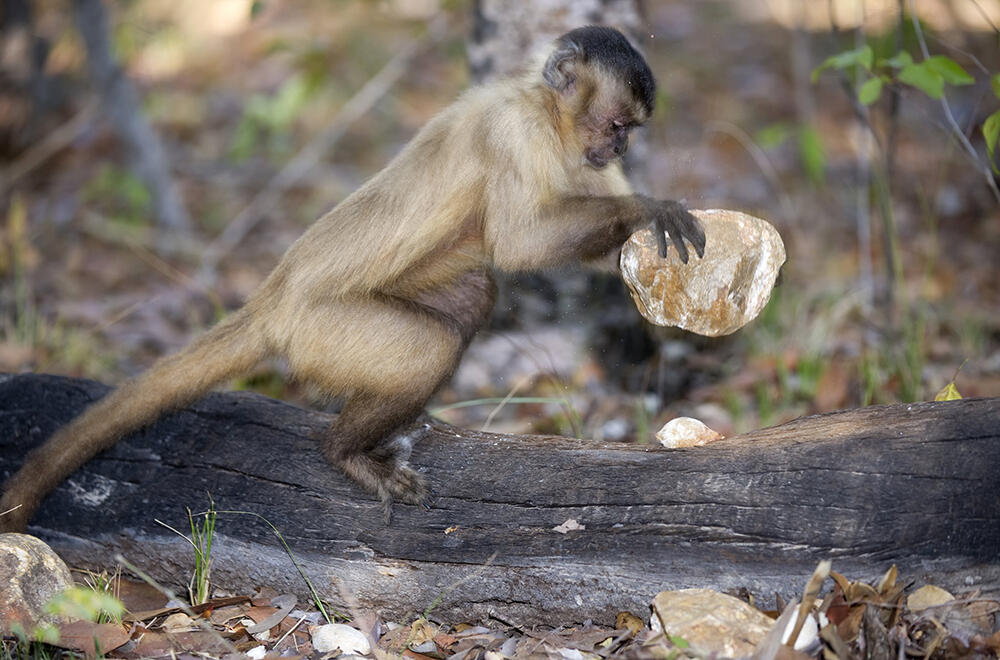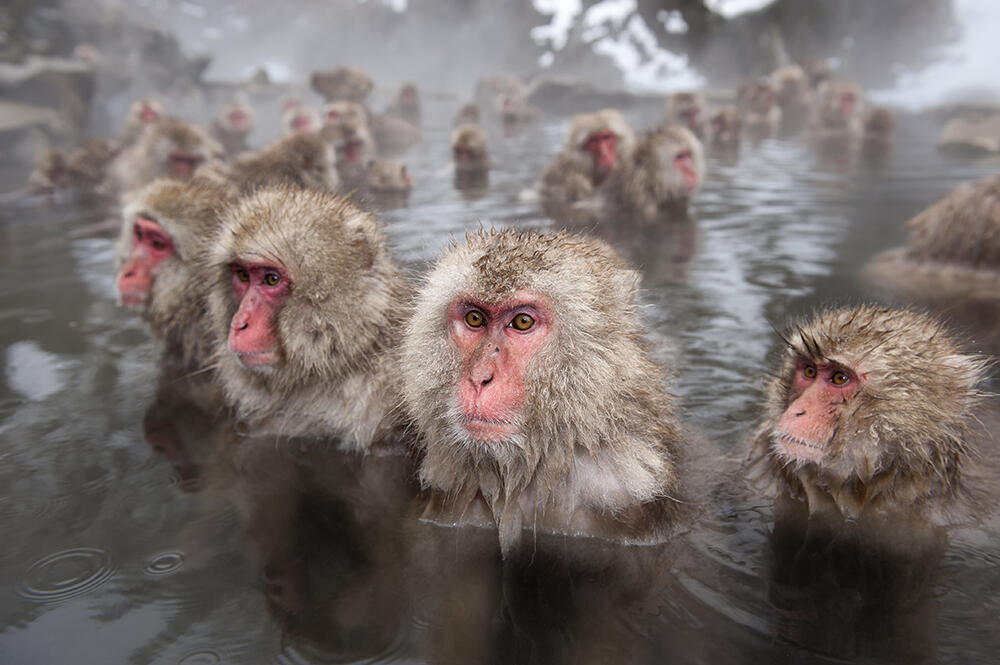You are here
Amazing animal cultures

This article is an excerpt from “Animal Intelligence Revealed”, a report first published (in French) in issue 14 of the journal Carnets de science.
In October 1960, in the heart of the Tanzanian rainforest, Jane Goodall made a discovery that would radically alter our perception of the cognitive abilities of animals. The young British ethologist observed, for the first time in a natural environment, a non-human animal devising and using a tool – in this case a chimpanzee spearing termites with a twig cleverly inserted into their mound. Since then there have been numerous observations of tool use among our closest biological cousins (we share more than 98% of our genome with them), revealing the complexity of this type of behaviour in the animal kingdom.
“The most famous study dates from the 1980s and focuses on nut cracking,” reports Christophe Boesch, primatologist at the Max Planck Institute for Evolutionary Anthropology in Leipzig, Germany. “It was discovered that in order to crack open the five species of nuts that feature in their diet, the chimpanzees of the Taï forest in Ivory Coast used not one but three different tools, in keeping with the time-tested model of hammer and anvil. They would place a nut on a tree root, to serve as an anvil, and break it with a stone or a stick depending on the fruit’s hardness. To eat Panda oleosa, the hardest of all African nuts, they would choose a piece of granite weighing at least two kilos, a stone that is hard to find in the tropical rainforest.”
In captivity, primates that are given the appropriate equipment engage in very human-like manual activities. Some gorillas, chimpanzees and orangutans show a real proclivity for drawing, with their own individual styles and colour choices, as recently demonstrated by Cédric Sueur, an ethologist at the Hubert Curien Pluridisciplinary Institute (IPHC)1. Others play games on touchpads…
Birds, the “feathered apes”
Yet primates, with their hands so similar to ours, are not the only animals to invent innovative technical solutions. Birds, who of course are deprived of hands, have proved to be excellent tinkerers, to the surprise of researchers… “Until 20 years ago, they were thought to be capable only of reflex-type reactions or conditioned stimulus-response learning,” says Dalila Bovet of the Laboratory of Compared Ethology and Cognition (LECD) at Université Paris-Nanterre.
The observations and experiments conducted in recent years among corvids and psittacines (the family of parrots and parakeets) have fundamentally changed our perceptions, to the point that Bovet has no hesitation in describing these birds as “feathered apes”. In Indonesia, Goffin’s cockatoos have been observed using no fewer than three tools in succession to procure wild mango seeds, one of their favourite foods. After removing the rind of the fruit with their beaks, they find a twig solid enough to wield as a lever to open the nut, before piercing with a splinter the membrane around the precious seeds, which they extract with a piece of wood that they have flattened for that purpose.
In a controlled environment, crows and parakeets are able to use what researchers call “meta-tools” – those that can serve to make other devices, which are in turn used to obtain a coveted treat. For example, a bird takes hold of a stick hanging from a string in order to push a stone out of an open-ended horizontal tube, then drops the stone into a container of water, which raises the level enough for the animal to reach a piece of food floating on the surface… All in just a few minutes! “Not only are birds perfectly capable of innovating in situations that are new to them, but they’re also capable of planning,” Bovet points out.
The “Swiss Army knife” of New Caledonian crows
The crows of New Caledonia are not to be outdone. To catch insects burrowing under tree bark, they cut spatulas from the broad, stiff leaves of the Pandan plant, chosen specifically for that purpose. “The crow follows a multi-step procedure,” the researcher recounts. “It cuts long strips from the leaves, in which it makes ladder-like indentations.” Even more surprisingly, the production technique varies among individuals and from one geographic zone to another. Some birds cut out thin even strips, while others favour a wide base and a tapered tip, which lends itself to a number of different uses. “The latter is a veritable Swiss Army knife, very efficient from a functional point of view,” Bovet explains.

From there to positing the existence of genuine cultural behaviour patterns among animals, specific to certain groups, it’s a short step – and one that today’s scientists are more than willing to take. Primates, birds, and also cetaceans are endowed with unique forms of know-how. It has recently been shown that killer whale populations in different locations around the globe do not pursue the same prey and do not use the same hunting techniques. “Cultural behaviour is a pattern present in one group of a given species and absent in at least another,” Sueur explains. “This type of behaviour is not determined by genetic makeup and thus requires social learning, both horizontal (between individuals) and vertical (from generation to generation).” That is why it is observed primarily among so-called “social” species, which cultivate relationships between congeners, and in which the young spend periods of several months to several years with their elders.
For the past ten years Sueur has been pursuing a fascination for Japanese macaques, a forest-dwelling species found on every island of the archipelago except Hokkaido. The monkeys’ distribution, along with their well-known flexibility, constitutes a tremendous asset for researchers interested in cultural behaviour. “The first indication of an animal culture dates back to the 1950s, when the Japanese researcher Kinji Imanishi handed out sweet potatoes on Koshima Island to lure the monkeys into an open area where he could observe them more easily,” Sueur recounts. “He could not have been more surprised when a young female, which he named Imo (“sweet potato” in Japanese), began to wash the grit-covered potatoes in seawater. In a few years this new behaviour spread to some 50 individuals, and is still seen today.”
The macaques’ hot bath culture
Even more amazing for animals that supposedly do not like water is the bathing culture that was discovered a few years later at the Jidokudani Yaen-Koen hot springs, obviously mimicking human practices. “To date, this is the only wild mountain population in Japan that takes hot baths,” Sueur notes. The habit has been quite beneficial for the monkeys, by reducing the stress of cold weather. On another island, they have developed a different technique for enduring harsh winters. In Shodoshima, at sunset the monkeys huddle together forming clusters of 20, 30 or even 40 individuals, a practice called sarudango – literally, “monkey dumplings”. “This behaviour, observed at nightfall, is not found in any of the monkey populations further north,” the researcher reports.
“Geography is a determining factor for culture,” Boesch explains. “The five nuts consumed by the chimpanzees of the Ivorian Taï forest are found all over tropical Africa, from Gabon to Congo and Cameroon. But the chimps in those countries don’t eat them, and therefore have no nut cracking techniques.” Natural borders, as in Japan, seem to play a key role in the cultural differentiation of groups. “In Ivory Coast, chimpanzees west of the Sassandra River, one of the country’s largest waterways, crack nuts, but those on the east side do not,” the scientist adds.
Evolving practices

While research on animal cultures continues to gain momentum, one question remains sensitive among ethologists: can animals be said to experience cumulative cultural evolution? In other words, are they capable of transforming a practice or behaviour over successive generations, as was the case in the history of the human species? For Dalila Bovet, the example of the New Caledonian crow stands as proof: “The tool with the wider base, the famous ‘Swiss Army knife’, is undeniably an improvement over the initial invention.”
The behavioural ecologist Étienne Danchin, a research professor emeritus at the EDB in Toulouse2, denounces the arrogance inherent in the question (“When will humans stop thinking they are superior to other animal species?”), evoking the above-mentioned Japanese macaques of Koshima Island. “In just a few decades, because of a simple potato washed in the sea, forest macaques that used to shun water have adopted a waterfront lifestyle. The young monkeys have started playing in the water and the adults can now catch and eat fish… There could be no better example of cultural accumulation,” states the scientist, a specialist in non-genetic inheritance.
Support for the ethologists’ assertion might come from archaeology. Excavations in the Taï forest have uncovered stone shards that are thousands of years old and may have been used by chimpanzees. But the findings of these studies are still highly disputed. And some of the tools used by animals – such as leaves and twigs – do not survive for centuries. Danchin urges his colleagues to change their perspective on animal cultures: “We don’t really see these phenomena because we are obsessed with the hypertechnology of our modern-day society, our smartphones, etc. As a result, we forget too easily that we also struck stones and used pieces of wood for hundreds of thousands of years before getting where we are today. And yet we were every bit as human back then.” ♦
-----------------------------------------------------------
Social learning: insects can do it too!
“Even in the late 20th century, insects were often considered to be mere robots,” explains Étienne Danchin3. “But we are beginning to observe that these invertebrates are also capable of sophisticated social learning – the key to any cultural tradition within a group.” The proof can be seen in drosophila, the tiny flies used in so many laboratory studies, in which the researcher has successfully induced a new habit: the choice of sexual partner. “In mammals, including humans, such choice is strongly influenced by the group. As it turns out, the same is true for drosophila.” After putting female flies together with males covered with a green powder, Danchin determined that the young female drosophila present at the mating scene later showed a preference for green males. This new behaviour could be transmitted over dozens of generations – up to several thousand according to a statistical model, or the equivalent of 274 years to put it in more biologically meaningful terms. Not only do females learn from others, but if they are shown two contradictory practices – for example, with 60% of the individuals observed choosing a green male and 40% a pink one – they adopt the behaviour of the majority and set their sights on a green mate. A decidedly conformist choice. ♦
For further reading on this topic:
Animals: from mechanical objects to sentient subjects













